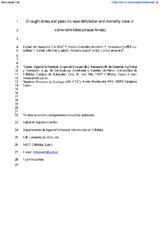Drought stress and pests increase defoliation and mortality rates in vulnerable Abies pinsapo forests
Autor
Navarro Cerrillo, Rafael M.
González-Moreno, Pablo
Ruiz Gómez, Francisco José
Sánchez-Cuesta, Rafael
Gazol, Antonio
Camarero, J. Julio
Editor
Forest Ecology and ManagementFecha
2022Materia
Forest healthMonitoring network
Defoliation rate
Mortality rate
Mediterranean fir forests
METS:
Mostrar el registro METSPREMIS:
Mostrar el registro PREMISMetadatos
Mostrar el registro completo del ítemResumen
Forest ecosystems are increasingly exposed to the combined pressure of climate change and attacks by pests and pathogens. These stress factors can threaten already vulnerable species triggering dieback and rising defoliation and mortality rates. To characterize abiotic (drought, climate warmings) and biotic (pathogens) risks and their spatiotemporal patterns we quantified the recent loss of vitality for the endangered and relict Abies pinsapo forests from Andalusia, south-eastern Spain. Abies pinsapo is an iconic Mediterranean fir showing a high vulnerability to drought stress and also to several pests (Cryphalus numidicus) and root rot fungi (Armillaria mellea). We analyzed a monitoring network dataset of radial growth, defoliation and mortality from 2001 to 2017 including 1025 trees situated in three major mountain ranges (Sierra de Grazalema, Sierra de las Nieves, and Sierra Bermeja). We fitted several statistical models to determine the main drivers of changes in defoliation, a proxy of tree vigor, and mortality. Defoliation and mortality rates were much higher towards the East of the study area, mirroring the gradient from Atlantic to Mediterranean climatic conditions. In the most affected stands tree defoliation increased in response to a combination of long and severe droughts, with attacks by the beetle C. numidicus. Mortality rates increased in response to a higher defoliation rate, a lower relative radial-growth rate, long and severe droughts and a higher incidence of A. mellea. Our findings illustrate the value of monitoring networks recording changes in forest health to quantify and forecast future vulnerability of threatened tree species.

